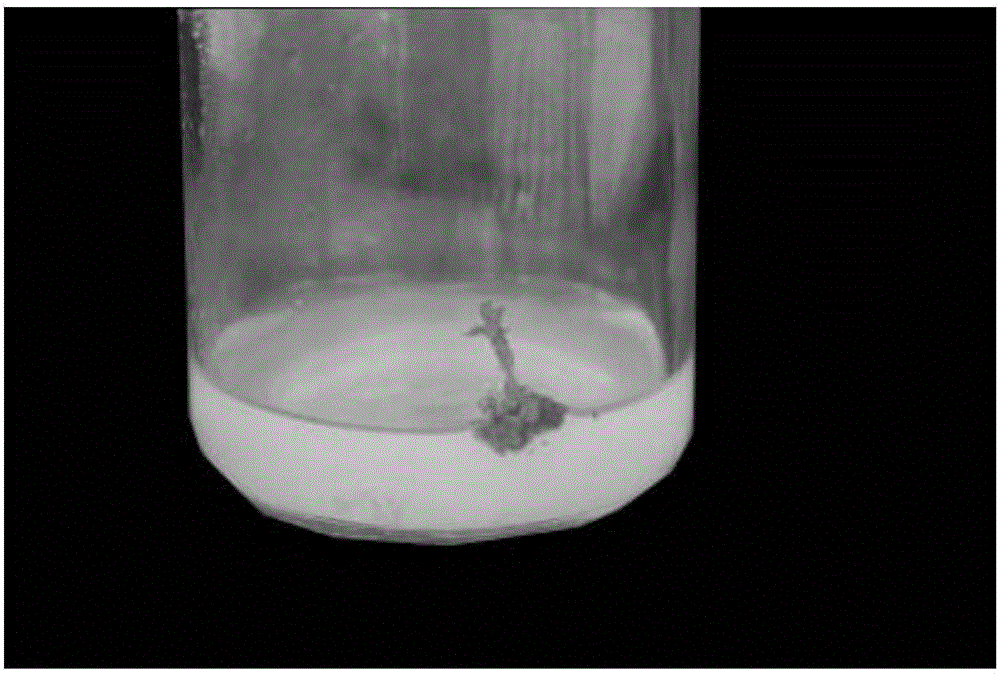Efficient regeneration method with zenia insignis leaves being explants
A high-efficiency regeneration and explant technology, applied in the field of plant tissue culture, can solve the problems that tissue culture has not yet been reported, and achieve the effect of strong repeatability, convenient operation and wide range of materials
- Summary
- Abstract
- Description
- Claims
- Application Information
AI Technical Summary
Problems solved by technology
Method used
Image
Examples
Embodiment 1
[0033] Step 1: Seed pretreatment. Put the seeds in a water bath and soak them in a water bath at 85°C for 12 minutes. Finally, spread the seeds on a petri dish with wet filter paper, and keep the filter paper wet all the time. After the seeds were placed in the petri dish for 24 hours, healthy and obviously swollen seeds were selected for the next test operation.
[0034] Step 2: Disinfect and sterilize the seeds. On a sterile ultra-clean bench, sterilize with 75% alcohol for 28 seconds, rinse with sterile water once; sterilize with 0.15% mercuric chloride for 8 minutes, and rinse thoroughly with sterile water for 5 times. Seeds were sown in blank (without any hormone) MS medium for cultivation at a cultivation temperature of 25±2°C, light intensity of 1500lx, and light duration of 15h. Seed germination was observed, and the germination rate was 96.54%.
[0035] Step 3: Obtain tissue culture materials. After 7 days, it was found that the seeds began to germinate, and the ...
Embodiment 2
[0039] Step 1: Seed pretreatment. Put the seeds in a water bath and soak them in a water bath at 90°C for 8 minutes. Finally, spread the seeds on a petri dish with wet filter paper, and keep the filter paper wet all the time. After the seeds were placed in the petri dish for 24 hours, healthy and obviously swollen seeds were selected for the next test operation.
[0040] Step 2: Disinfect and sterilize the seeds. On a sterile ultra-clean bench, sterilize with 75% alcohol for 30 seconds, rinse with sterile water once; sterilize with 0.1% mercuric chloride for 10 minutes, and rinse thoroughly with sterile water for 5 times. Seeds were sown in blank (without any hormone) MS medium for cultivation at a cultivation temperature of 25±2°C, light intensity of 2000lx, and light duration of 12h. Seed germination was observed, and the germination rate was 98%.
[0041] Step 3: Obtain tissue culture materials. After 7 days, it was found that the seeds began to germinate, and the hypo...
Embodiment 3
[0045] Step 1: Seed pretreatment. The seeds were placed in a water bath and soaked in a water bath at 88°C for 10 min. Finally, spread the seeds on a petri dish with wet filter paper, and keep the filter paper wet all the time. After the seeds were placed in the petri dish for 24 hours, healthy and obviously swollen seeds were selected for the next test operation.
[0046] Step 2: Disinfect and sterilize the seeds. On a sterile ultra-clean bench, sterilize with 75% alcohol for 25 seconds, rinse with sterile water once; sterilize with 0.2% mercuric chloride for 5 minutes, and rinse thoroughly with sterile water for 5 times. Seeds were sown in a blank (without any hormone) MS medium for culture, the culture temperature was 25±2°C, the light intensity was 2500lx, and the light time was 10h. Seed germination was observed, and the germination rate was 95%.
[0047] Step 3: Obtain tissue culture materials. After 7 days, it was found that the seeds began to germinate, and the hy...
PUM
 Login to View More
Login to View More Abstract
Description
Claims
Application Information
 Login to View More
Login to View More - R&D
- Intellectual Property
- Life Sciences
- Materials
- Tech Scout
- Unparalleled Data Quality
- Higher Quality Content
- 60% Fewer Hallucinations
Browse by: Latest US Patents, China's latest patents, Technical Efficacy Thesaurus, Application Domain, Technology Topic, Popular Technical Reports.
© 2025 PatSnap. All rights reserved.Legal|Privacy policy|Modern Slavery Act Transparency Statement|Sitemap|About US| Contact US: help@patsnap.com



